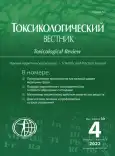Подходы Европейского законодательства к регулированию обращения с отходами (обзор)
- Авторы: Хамидулина Х.Х.1,2, Назаренко А.К.1,3, Тарасова Е.В.1, Рабикова Д.Н.1,2, Петрова Е.С.4, Филин А.С.4
-
Учреждения:
- Филиал «Российский регистр потенциально опасных химических и биологических веществ» ФБУН «Федеральный научный центр гигиены им. Ф.Ф. Эрисмана» Федеральной службы по надзору в сфере защиты прав потребителей и благополучия человека
- ФГБОУ ДПО «Российская медицинская академия непрерывного профессионального образования» Министерства здравоохранения Российской Федерации
- ФГБОУ ВО «Российский химико-технологический университет имени Д.И. Менделеева»
- ФГАОУ ВО «Первый Московский государственный медицинский университет имени И.М. Сеченова Министерства здравоохранения Российской Федерации (Сеченовский Университет)»
- Выпуск: № 4 (2022)
- Страницы: 255-266
- Раздел: Химическая безопасность
- Статья опубликована: 01.09.2022
- URL: https://gynecology.orscience.ru/0869-7922/article/view/641463
- DOI: https://doi.org/10.47470/0869-7922-2022-30-4-255-266
- ID: 641463
Цитировать
Полный текст
Аннотация
Введение. Обращение с отходами, в том числе опасными, относится к вопросам, которые регулируются Директивами Европейского союза, обязательными для исполнения всеми странами-членами ЕС. Различные Директивы ЕС по отходам утверждались начиная с 1975 года, а в 2008 году была принята основополагающая Рамочная директива ЕС по отходам (Directive 2008/98/EC of the European Parliament and of the Council of 19 November 2008 on waste and repealing certain Directives), в которой описана политика по управлению отходами, определены классификация отходов и методы их переработки и захоронения.
Материал и методы. При подготовке обзора использованы нормативно-правовые документы (в частности, Директивы, Регламенты ЕС в области обращения с отходами) и руководства по практическому обращению с отходами в ЕС.
Результаты и обсуждение. В обзоре представлена методология классификации отходов, их деления на неопасные и опасные. Описаны коды и классы опасности, пороговые значения, т.е. критерии отнесения отходов к опасным.
Заключение. На этапе анализа Европейского законодательства, касающегося обращения с отходами, особое внимание ЕС уделяет классификации отходов как важному инструменту дифференциации их потока и планирования обращения с отдельными их видами. Основной принцип классификации — разграничение отходов по степени опасности для окружающей среды и человека, позволяющий свести к минимуму их негативное влияние.
Участие авторов:
Хамидулина Х.Х. — редактирование, утверждение окончательного варианта статьи, ответственность за целостность всех частей статьи;
Назаренко А.К. — концепция и дизайн исследования, сбор и обработка материала, написание текста, редактирование;
Тарасова Е.В. — сбор материала;
Рабикова Д.Н., Петрова Е.С., Филин А.С. — редактирование.
Конфликт интересов. Авторы заявляют об отсутствии конфликта интересов.
Финансирование. Исследование финансировалось за счет государственной программы «Обеспечение химической и биологической безопасности Российской Федерации».
Поступила в редакцию: 13.07.2022 / Принята в печать: 21.07.2022 / Опубликована: 30.08.2022
Ключевые слова
Об авторах
Халидя Хизбулаевна Хамидулина
Филиал «Российский регистр потенциально опасных химических и биологических веществ» ФБУН «Федеральный научный центр гигиены им. Ф.Ф. Эрисмана» Федеральной службы по надзору в сфере защиты прав потребителей и благополучия человека; ФГБОУ ДПО «Российская медицинская академия непрерывного профессионального образования» Министерства здравоохранения Российской Федерации
Автор, ответственный за переписку.
Email: director@rosreg.info
ORCID iD: 0000-0001-7319-5337
Доктор медицинских наук; директор Филиала РПОХБВ ФБУН ФНЦГ им. Ф.Ф. Эрисмана Роспотребнадзора, профессор, заведующий кафедрой гигиены ФГБОУ ДПО РМАНПО Минздрава России, 121087, Москва.
e-mail: director@rosreg.info
РоссияАндрей Константинович Назаренко
Филиал «Российский регистр потенциально опасных химических и биологических веществ» ФБУН «Федеральный научный центр гигиены им. Ф.Ф. Эрисмана» Федеральной службы по надзору в сфере защиты прав потребителей и благополучия человека; ФГБОУ ВО «Российский химико-технологический университет имени Д.И. Менделеева»
Email: secretary@rosreg.info
ORCID iD: 0000-0003-0178-4540
Россия
Елена Владимировна Тарасова
Филиал «Российский регистр потенциально опасных химических и биологических веществ» ФБУН «Федеральный научный центр гигиены им. Ф.Ф. Эрисмана» Федеральной службы по надзору в сфере защиты прав потребителей и благополучия человека
Email: secretary@rosreg.info
ORCID iD: 0000-0002-4020-3123
Россия
Динара Нуруллаевна Рабикова
Филиал «Российский регистр потенциально опасных химических и биологических веществ» ФБУН «Федеральный научный центр гигиены им. Ф.Ф. Эрисмана» Федеральной службы по надзору в сфере защиты прав потребителей и благополучия человека; ФГБОУ ДПО «Российская медицинская академия непрерывного профессионального образования» Министерства здравоохранения Российской Федерации
Email: secretary@rosreg.info
ORCID iD: 0000-0003-3965-7600
Россия
Екатерина Сергеевна Петрова
ФГАОУ ВО «Первый Московский государственный медицинский университет имени И.М. Сеченова Министерства здравоохранения Российской Федерации (Сеченовский Университет)»
Email: ekaterinapetrova9@mail.ru
ORCID iD: 0000-0001-6838-5398
Россия
Андрей Сергеевич Филин
ФГАОУ ВО «Первый Московский государственный медицинский университет имени И.М. Сеченова Министерства здравоохранения Российской Федерации (Сеченовский Университет)»
Email: andrey.filin@mail.ru
ORCID iD: 0000-0002-9724-8410
Россия
Список литературы
- Directive 2008/98/EC of the European Parliament and of the Council of 19 November 2008 on waste and repealing certain Directives. Available at: www.eur-lex.europa.eu/legal-content (accessed 08 June 2022)
- Commission Decision 2000/532/EC of 3 May 2000 replacing Decision 94/3/EC establishing a list of wastes pursuant to Article 1(a) of Council Directive 75/442/EEC on waste and Council Decision 94/904/EC establishing a list of hazardous waste pursuant to Article 1(4) of Council Directive 91/689/EEC on hazardous. Available at: www.eur-lex.europa.eu/legal-content (accessed 08 June 2022)
- Commission Decision 2014/955/EU of 18 December 2014 amending Decision 2000/532/EC on the list of waste pursuant to Directive 2008/98/EC of the European Parliament and of the Council. Available at: www.eur-lex.europa.eu/legal-content (accessed 08 June 2022)
- Базельская конвенция о контроле за трансграничной перевозкой опасных отходов и их удалением (1992 г.). Доступно: www.basel.int
- Уланова О.В., ред. Комплексное устойчивое управление отходами. Жилищно-коммунальное хозяйство: учебное пособие. М.: Издательский дом Академии Естествознания; 2016.
- Guidance on using the European Waste Catalogue (EWC) to code waste. Scottish Environment Protection Agency. 2018
- Курбатова А.И., Челядинова Е.Ю., Зотова О.С. Сравнительный анализ систем классификации отходов в Российской Федерации и Европейском союзе. Бюллетень науки и практики. Электронный журнал. 2017, 2 (15): 163-169. Доступно: https://www.bulletennauki.com/kurbatova
- Обращение с опасными отходами в России и некоторых странах ЕС (2019). Доступно: www.bellona.ru
- Подходы к законодательному и нормативному регулированию в области обращения отходов в странах Европейского союза. Доступно: www.waste.ru
- Regulation (EC) No 1272/2008 of the European Parliament and of the Council of 16 December 2008 on classification, labelling and packaging of substances and mixtures, amending and repealing Directives 67/548/EEC and 1999/45/EC, and amending Regulation (EC) No 1907/2006. Available at: www.eur-lex.europa.eu/legal-content (accessed 08 June 2022)
- Guidance for the compilation and reporting of data on municipal waste according to Commission Implementing Decisions 2019/1004/EC and 2019/1885/EC, and the Joint Questionnaire of Eurostat and OECD (Version 12.08.2021). Avaliable at: www.ec.europa.eu
Дополнительные файлы






